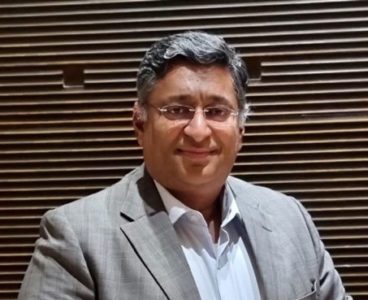Mitrahsoft Solutions is a premier software development company specializing in custom application development, outsourcing services, and digital transformation. Established in 2010, the firm delivers scalable and adaptive solutions, focusing on technologies like ColdFusion, ReactJS, Python, and cloud services (AWS, Azure). Mitrahsoft assists clients, ranging from startups to established enterprises, with full-stack development, mobile applications, and product engineering. They are known for providing dedicated teams and leveraging their expertise to help businesses in Tier 2 cities and beyond to digitize and optimize their operations. The company aims to drive growth by delivering technical excellence and a focus on customer requirements.
CMR sat down with Mr. Shriram Prabhu, Vice President – Technology and Delivery at Mitrahsoft Solutions, to discuss the accelerating digital adoption in India’s Tier 2 and Tier 3 cities, the challenges for IT investment, and the future role of technology, particularly in traditional businesses.
How would you describe the current pace of technological advancement and digital adoption in Tier 2 and Tier 3 cities?
The advancement is booming right now. In terms of technical talent and capabilities, there’s no major competition between Tier 1, Tier 2, and Tier 3. The people are everywhere. We, even in Tier 2 and Tier 3 cities, are working on a multitude of advanced technologies, including integrations and various other complex projects. The core talent is absolutely capable.
However, the primary challenge is the facility and the ecosystem. It’s not about the technology itself, but the lack of forums, events, and platforms that would bring Tier 2 and Tier 3 cities more into the limelight as technical evangelist hubs. Most companies currently entering these cities are focusing on BPO or KPO operations, which is unfortunate. We see a significant number of technical professionals having to travel from their home cities to Tier 1 centres for technical jobs. We need a space to grow, specifically in terms of hosting more events and fostering a more dynamic IT ecosystem.
On the subject of growth, what role do state government policies and budgets play in the decision-making process for companies in Tier 2 and Tier 3 cities?
The government’s role, particularly in states like Tamil Nadu, is crucial. For instance, entities like ELCOT (Electronics Corporation of Tamil Nadu) need to look at the pricing of space. Currently, the rates for facilities in Tier 2 and Tier 3 cities are often comparable to Tier 1 cities. To truly incentivize growth and expansion, the government must offer some form of enhanced remuneration or benefit for setting up in Tier 2/3 locations.
We acknowledge good initiatives, such as the government pushing schemes like ‘TIDEL Neo,’ which is injecting information into the IT industry. However, particularly in the southern part of Tamil Nadu—cities like Madurai and Tiruchirappalli (Trichy)—there’s a strong expectation for a focused IT hub. We see the government largely focusing on established industrial hubs like Coimbatore. My question is, why not focus on developing dedicated IT hubs in cities like Trichy or Madurai? They have far better infrastructure, including better airport and shipping connectivity, compared to a city like Sivakasi, yet they are not being prioritised for IT infrastructure.
Moving from the IT sector to general businesses: How open are traditional family-run businesses to adopting new technologies?
Family businesses are increasingly open to adoption, often starting with social media platforms. We can’t dismiss platforms like Instagram or Facebook; they are now powerful social media marketing tools. Whether it’s a small-scale industry, a food chain, or a jewellery maker, they are adapting to platforms like Instagram and other e-commerce platforms like Amazon, which are encouraging small-scale industries to come online.
Technologies, especially Meta’s APIs for Instagram and Facebook, are significantly helping these businesses strengthen their presence. They are finding it easier to promote their products, reach out to customers, and streamline the customer acquisition process.
Looking ahead, where do you see the biggest IT investment happening in organizations, particularly those based in Tier 2 cities, in the coming year?
Right now, there is a clear readiness to invest; the market is booming. We are eagerly awaiting the opening of major IT parks like TIDEL in Trichy or Madurai. Once the market is officially opened, people will be quick to adapt and invest. The reluctance isn’t on the demand side, but on the investor side; I’m not entirely sure why more investors aren’t yet flocking to these promising Tier 2/3 locations.
Regarding which business segment will see the most investment, I predict the focus will be heavily on Future Marketing, powered by Artificial Intelligence (AI). We see a large number of startups emerging daily, yet a common point of failure is marketing. AI-powered future marketing will be critical to their success.
For a traditional family business—say, a local cracker maker—their investment won’t be in core IT development, but in promotion and marketplace reach. Earlier, you had to physically visit a store; now, every business has a website, an Instagram account, or a presence on a specific industrial marketplace. Technology is about enhancing this reach. We need more platforms and an ecosystem that brings these specific industry marketplaces into a common, easily accessible forum, and AI will be key to enhancing this technology further.
As a solution provider, what are the key challenges you face in convincing businesses and investors to commit capital to IT adoption?
To be frank, the primary challenge is the sheer volume of startups and ideas flooding the market, which is confusing investors. Everyone is pitching an idea, but a significant portion of them lack a proper market analysis, a clear roadmap for future growth, or a robust plan beyond the initial months.
Investors are wary of funding just an idea. They need to see at least 10-20% of the concept already worked out. The lack of clear roadmaps, especially for the three-to-six-month horizon, is making investors much more cautious. This has led to a reduction in seed funding and investment in many sectors over the past six months to a year. While SMEs have brilliant ideas, their weak point is the absence of a clear, executable roadmap. This uncertainty is the biggest hurdle we face in encouraging investment.













